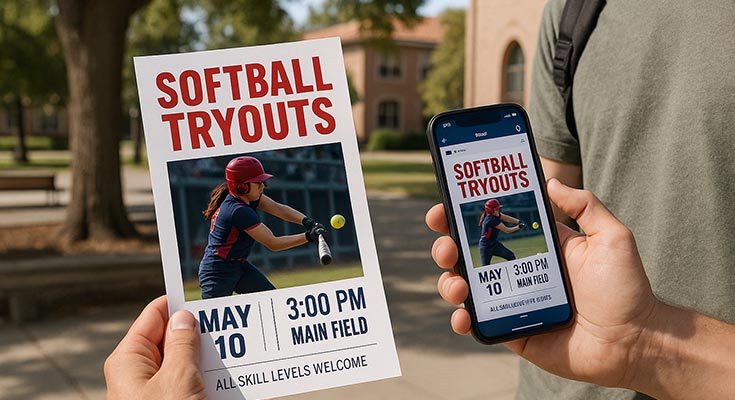Distributing your softball flyer effectively means more than just posting it, it starts with a strong design. Use a Softball flyer template to create a professional and eye-catching flyer that’s ready for action. From there, focus on smart placement, ideal timing, and targeted community outreach. Prioritize high-traffic family areas like schools, community centers, and sports facilities, and combine your physical efforts with digital strategies such as social media groups and neighborhood apps.
Successful campaigns speak directly to parent decision-makers, align with seasonal planning windows, and rely on trackable methods to drive registrations. If you’re unsure how to get started or want inspiration from proven layouts, our softball flyer design guide offers detailed tips and examples to help you stand out. High-performing organizers use a mix of bulletin boards, QR codes, email campaigns, and local partnerships to increase visibility and boost credibility. With the right timing, like spring promotion for summer leagues, your flyer reaches families at just the right moment.
This guide covers everything you need to know about where and how to distribute your softball flyer for maximum sign-ups, using proven multi-channel strategies that turn interest into committed participation.
How To Choose The Best High-traffic Locations For Softball Flyer Distribution
Choose high-traffic locations for softball flyer distribution by targeting family-focused venues, community gathering spots, and youth activity centers. Best locations include elementary and middle schools, community centers, recreation facilities, youth sports complexes, libraries, and family-oriented retail locations. Prioritize areas with heavy parent traffic, consider permission requirements, and focus on locations where families make activity decisions. Effective placement requires weather-resistant strategies, optimal timing coordination, and demographic alignment with target age groups.
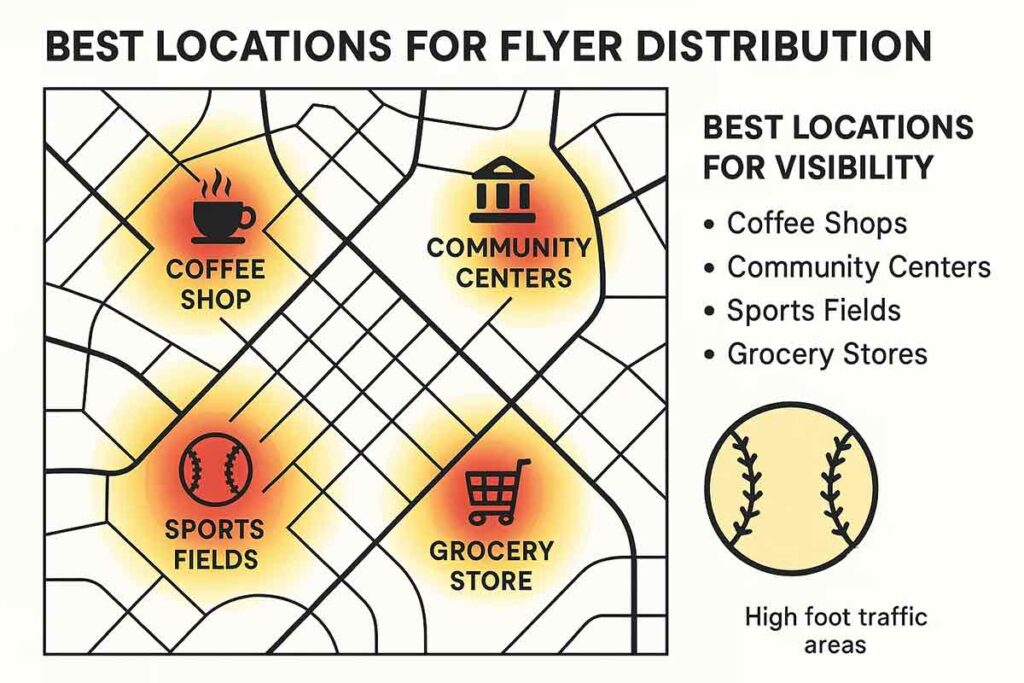
Identify Prime Community Gathering Spots for Maximum Visibility
Start by mapping community centers and municipal buildings with active family programming. These locations offer consistent parent traffic throughout the week, making them ideal for softball flyer distribution. Focus on facilities hosting youth programs, family events, and community meetings where parents naturally gather to discuss activities.
Public libraries and educational resource centers provide excellent placement opportunities due to their family-friendly atmosphere and high parent engagement. Position flyers near children’s sections, community bulletin boards, and programming areas where parents spend time during story hours and educational events.
Shopping centers and family-oriented retail locations offer consistent exposure to your target demographic. Grocery stores, children’s clothing stores, and family restaurants typically allow community postings on designated bulletin boards. These locations capture parents during routine activities when they’re most likely to consider new youth programs.
Parks and recreation facilities with existing youth programming create natural synergy for softball promotion. Parents visiting these locations are already engaged in youth activities, making them more receptive to additional sports opportunities. Coordinate with facility staff to identify optimal placement areas near registration desks and program information centers.
According to CEHD (2024), parks, recreation centers, and community activity hubs are essential venues for youth sports access and they naturally attract families and caregivers throughout the week, making them ideal locations for distributing softball program flyers .1
Leverage School Zones and Educational Facilities for Parent Reach
Elementary and middle schools represent the highest-value locations for softball flyer distribution due to direct access to your target age demographic. Develop partnership strategies with school administrators by emphasizing community benefit and youth development aspects of your program.
After-school program coordination and pickup zone placement maximize exposure during peak parent traffic periods. Position materials where parents wait for children, creating natural reading opportunities during downtime. Focus on covered areas near main entrances and designated pickup zones for weather protection.
PTA meeting distribution and parent volunteer opportunities provide direct engagement with highly involved parents. These individuals often serve as community influencers, extending your reach through word-of-mouth recommendations. Coordinate with PTA leadership to present your program at meetings and distribute promotional materials.
School event timing and seasonal coordination considerations ensure maximum impact during enrollment periods. Align distribution with back-to-school events, sports registration windows, and parent-teacher conferences when families actively plan extracurricular activities.
Maximize Softball Flyer Visibility at Sports and Recreation Centers
Youth sports complexes and multi-use athletic facilities offer concentrated access to sports-minded families. These locations provide ideal demographic targeting since parents are already committed to youth athletics. Focus on bulletin boards, lobby areas, and facilities where families spend extended time during practices and games.
Swimming pools and community recreation centers attract families seeking youth activities year-round. Position flyers near membership desks, locker room entrances, and areas where parents observe activities. These locations often have less competition for bulletin board space compared to schools.
Dance studios and martial arts facilities with similar demographics create cross-promotional opportunities. Parents investing in one youth activity often consider additional programs for skill development or social opportunities. Establish reciprocal promotion agreements with complementary youth programs.
Seasonal sports facility rotation and cross-promotion opportunities maximize year-round exposure. During off-seasons for other sports, families actively seek alternative activities. Coordinate with facility managers to maintain consistent presence across multiple venues.
Implement Weather-Resistant Distribution Strategies and Placement Protection
Indoor location prioritization and backup strategies protect against weather-related visibility loss. Develop primary indoor locations for consistent exposure, using outdoor placements as supplementary reach rather than primary distribution channels.
Protective display methods and material durability ensure professional appearance throughout distribution periods. Use weather-resistant materials for outdoor placements and protective covers for extended exposure. Poor-quality, weathered flyers reflect negatively on program professionalism.
Seasonal adjustment tactics for outdoor placement account for weather patterns and facility usage changes. Shift focus to indoor locations during harsh weather periods and increase outdoor placement during favorable conditions when foot traffic increases.
Permission coordination and location relationship management create sustainable distribution networks. Maintain positive relationships with facility managers through professional communication and respect for posting policies. Regular check-ins ensure continued placement opportunities and demonstrate program legitimacy.
Track location performance by monitoring registration sources and adjusting placement strategies based on results. High-performing locations merit increased resource allocation, while underperforming areas require strategy modification or discontinuation.
Successful high-traffic location selection combines strategic demographic targeting with practical placement considerations. Focus on locations where parents actively engage in youth activity planning, maintain professional relationships with facility managers, and adapt strategies based on performance data for sustained registration growth.
Where To Post Softball Flyers For Maximum Parent And Player Engagement
Post softball flyers for maximum engagement at youth-focused venues, community centers, religious organizations, and family-friendly retail locations. Target locations include elementary schools, community centers, libraries, grocery stores, pediatric offices, and sports facilities where parents make activity decisions. Focus on bulletin boards, information centers, and high-visibility areas with parent traffic. Effective placement requires permission coordination, strategic timing, and demographic alignment with target families. Most successful posting combines multiple location types with community partnerships, seasonal timing optimization, and follow-up engagement strategies for maximum sign-up conversion and sustained visibility.
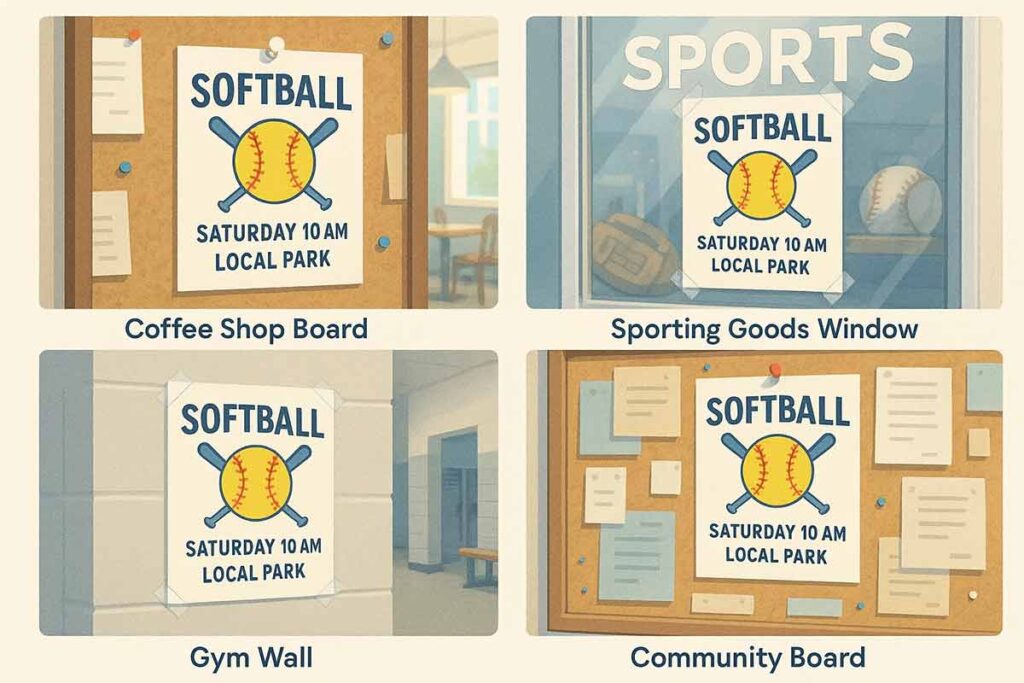
Distribution Strategies by Softball Flyer Type and Target Audience
Where to Post Softball Tournament Flyer
Tournament flyers perform best at competitive sports venues where serious players and families gather. Target youth sports complexes with multiple fields hosting ongoing tournaments, travel team meeting locations, and competitive training facilities. League administrative offices and registration centers provide direct access to organized teams seeking additional competition opportunities.
Post flyers on team dugouts and facility bulletin boards with proper permission. Coach and umpire meeting areas offer maximum reach within the sports community. Strategic timing requires distributing 4-6 weeks before tournament dates, coordinating with existing tournament schedules to avoid conflicts.
Kickstart your tournament promotion with our curated collection of softball tournament flyer designs.
- Energetic Green Softball Tournament Event Flyer
- Playful Cartoon Softball Tournament Event Flyer
- Dynamic Red Softball Tournament Sports Event Flyer
Read More: Softball Tournament Flyer Design: Complete Promotion Guide
Where to Post Softball Tryout Flyer
Tryout flyers need placement at locations where aspiring players and their families make decisions about competitive opportunities. Middle and high schools with existing softball programs offer direct access to age-appropriate candidates. Recreation department facilities and youth sports centers attract families exploring athletic options.
Focus on existing team practice locations and training facilities where skilled players train. Youth athletic development centers and sports training venues serve motivated athletes seeking advancement. School counselor offices and athletic department bulletin boards reach students during planning periods. Distribute 2-3 weeks before tryout dates, coordinating with school athletic calendars for optimal timing.
Here’s a curated selection of Softball Tryout Flyer designs to spark your creativity. Each links to a full preview page with easy customization options.
- Community Softball Tryouts Event Flyer
- Join Our Softball Team Tryouts Flyer
- Womens Softball Tryouts Announcement Flyer
Read More: How to Create Softball Tryout Flyer That Attract the Best Players
Where to Post Softball Fundraiser Flyer
Fundraiser flyers require community-wide visibility targeting supporters beyond immediate team families. Community centers and municipal buildings with high family traffic provide broad demographic reach. Local businesses supporting youth sports and community activities offer credible endorsement through display permission.
Grocery stores and family shopping centers capture parents during routine activities. The National Recreation and Park Association research indicates that community partnerships and multiple communication channels are most effective for reaching diverse family demographics in recreation programming (NRPA, 2020).2
Restaurants with family dining areas and community bulletin boards reach engaged community members. Churches and religious organizations with family programming connect with service-oriented families. Neighborhood association meetings and community events provide direct community access. Distribute 3-4 weeks before fundraiser events, coordinating with community calendars to maximize participation.
Discover Softball Fundraising Flyers designed for maximum impact. Every flyer supports customization for your team’s branding, fundraising goals, and event specifics.
- Softball Fundraiser Event Invitation Flyer
- Community Softball Fundraiser Game Flyer
- Flaming Softball Community Fundraiser Event Flyer
Read More: How to Create Softball Fundraiser Flyers That Drive Results
Where to Post Softball Camp Flyer
Camp flyers target families planning summer activities and skill development opportunities. Municipal recreation centers with youth programming attract families seeking structured activities. Sports facilities offering multi-sport camps provide cross-promotional opportunities with complementary programs.
Research from the Centers for Disease Control and Prevention shows that 54.1% of children aged 6-17 participate in organized sports, with participation rates varying significantly by family income and parental education levels (CDC, 2022).3
Elementary and middle schools during registration periods reach families planning summer schedules. Community pools and summer activity centers capture families already committed to summer programming. Youth-focused retail locations and sporting goods stores attract families purchasing athletic equipment. Pediatric offices and family healthcare facilities reach parents during routine appointments. Begin distribution in late winter/early spring for summer camps, coordinating with school break schedules.
Explore a gallery of vibrant softball camp flyer designs featuring bold colors, action shots, and playful typography. Customize any of them to promote your camp with energy and clarity.
Read More: Softball Camp Flyer Design Guide: Attract More Participants This Season
Where to Post Softball Game Flyer
Game flyers require quick community awareness for immediate attendance. Team facilities and practice locations provide direct access to players and families. Community centers and neighborhood gathering spots offer broad community visibility.
Local businesses supporting team activities demonstrate community partnership. School bulletin boards and parent communication areas reach families already engaged in youth activities. Sports bars and family restaurants with community connections attract local supporters. Municipal buildings and public information centers provide official community presence. Distribute 1-2 weeks before game dates, coordinating with team and community calendars.
Browse a curated selection of softball game flyer designs created to energize local match promotions—from rivalry showdowns to community games.
- Verdun Green Softball Game Flyer
- Sunday Morning Softball Game Flyer
- Mens Softball Upcoming Game Flyer
Where to Post Softball Clinic Flyer
Clinic flyers need placement at skill development locations where families invest in athletic improvement. Sports training facilities and athletic development centers attract motivated athletes seeking specialized instruction. School athletic departments and physical education offices reach students interested in skill enhancement.
Youth sports complexes with instructional programming offer direct access to families already investing in athletic development. Martial arts studios and skill-based youth programs provide cross-promotional opportunities with similar demographics. Dance studios and fitness centers with youth programming attract families prioritizing physical development. Distribute 2-3 weeks before clinic dates, coordinating with school and facility schedules.
Youth-Focused Venues That Drive Sign-Ups and Family Engagement
Elementary and middle school information centers with parent communication systems provide direct access to target demographics. After-school programs and childcare facilities capture families during pickup times when activity decisions occur. Youth-oriented retail locations and toy stores attract families shopping for children’s needs.
Pediatric offices and family healthcare facilities offer parent waiting areas with concentrated attention. These locations provide extended exposure time while parents focus on family-related decisions. Schedule placement during peak appointment times for maximum visibility.
Softball Flyer Strategies for Broad Reach at Community Centers and Municipal Buildings
Public bulletin boards and information centers with community programming focus attract engaged residents. Senior centers offer grandparent engagement opportunities with family connections to youth activities. City hall and municipal buildings provide high-traffic resident services areas with official credibility.
Public library children’s sections and family programming areas combine educational focus with family demographics. These locations demonstrate community partnership and provide credible endorsement for youth programs. Coordinate with library programming schedules for optimal timing.
Softball Flyer Promotion Through Religious Organizations and Community Group Partnerships
Church bulletin boards and family ministry programs offer access to youth-focused congregations. Community organization meeting spaces provide direct access to engaged families participating in organized activities. Neighborhood association meetings and communication channels reach residents invested in community development.
Scout groups and youth organization partnerships provide shared demographics with proven interest in structured youth activities. These partnerships offer credibility and cross-promotional opportunities with complementary programs.
Retail Locations with Family-Friendly Demographics and High Traffic
Grocery stores and family shopping centers capture parents during routine activities when they consider family scheduling. Sporting goods stores and athletic equipment retailers attract families already investing in youth sports. Children’s clothing stores and family-oriented businesses provide concentrated parent demographics.
Restaurant chains with family dining areas and community connections offer relaxed environments where families discuss activity options. These locations provide extended exposure time during meals and family discussions. Focus on establishments with community bulletin boards and family-friendly atmospheres.
Strategic Timing and Permission Coordination
Successful softball flyer placement requires advance permission coordination with location managers. Develop relationships with facility coordinators, school administrators, and business owners to ensure consistent placement opportunities. Maintain professional presentation and respect posting guidelines to preserve ongoing relationships.
Track permission renewal dates and maintain regular communication with location partners. Offer reciprocal promotional opportunities where appropriate to strengthen partnership relationships. Document successful locations and contact information for efficient campaign execution.
Performance Tracking and Location Optimization
Monitor sign-up sources through registration tracking to identify highest-performing locations. Use location-specific registration codes or QR codes to measure conversion rates by posting location. Analyze demographic alignment between posting locations and actual participants to optimize future placement strategies.
Adjust resource allocation based on performance data, focusing efforts on proven high-conversion locations. Maintain detailed records of location effectiveness, permission contacts, and optimal timing for systematic improvement.
This comprehensive approach to softball flyer placement maximizes parent and player engagement through strategic location selection, proper timing coordination, and sustainable community partnerships that drive consistent sign-up results across different program types and community demographics.
Read More: How to Create a Softball Flyer: A Complete Step-by-Step Guide
Digital Distribution Strategies: Beyond Physical Softball Flyer Placement
Digital distribution strategies for softball flyers extend reach beyond physical placement through social media targeting, email campaigns, and QR code integration. Effective approaches combine Facebook community groups, neighborhood apps, email marketing, and trackable digital assets. These methods enable precise audience targeting, instant engagement, and measurable results while maintaining cost efficiency. Digital channels complement physical distribution by reaching parents during decision-making moments, providing immediate registration access, and creating viral sharing opportunities that amplify campaign reach exponentially.
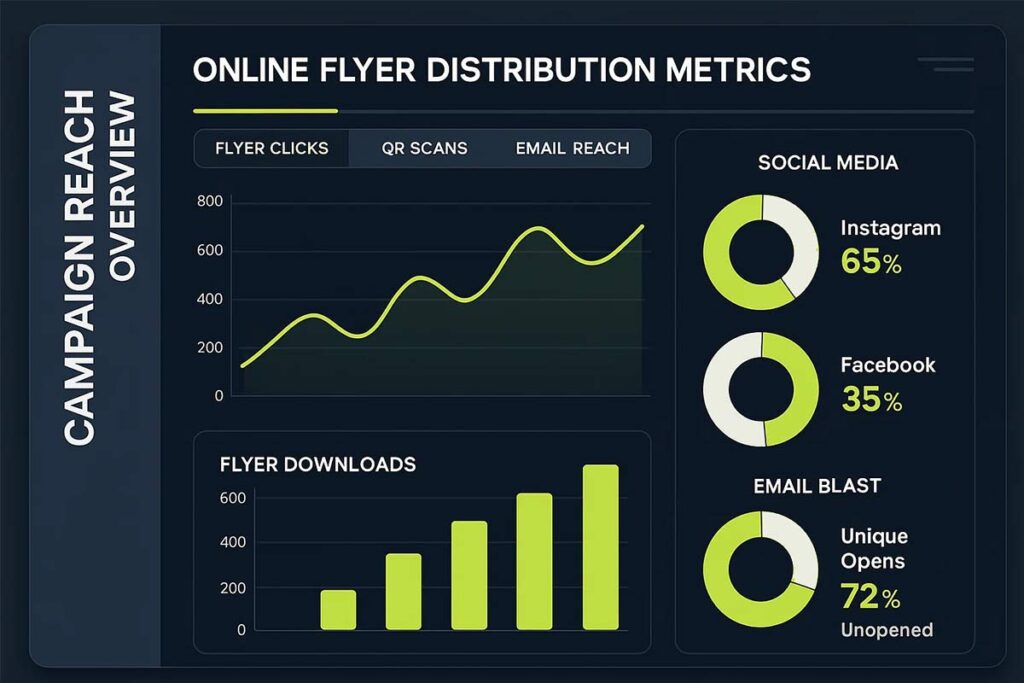
Social Media Groups and Community Pages for Targeted Reach
Facebook parent groups dominate digital softball flyer distribution, offering direct access to engaged family audiences. Search for groups like “[City Name] Youth Sports,” “Local Moms,” or “Community Events” with active membership. Post during peak engagement hours (7-9 AM, 6-8 PM) when parents check social media. Create compelling visuals that stand out in crowded feeds, include clear registration information, and respond promptly to comments.
Research indicates that parents increasingly turn to social media platforms as primary information sources for youth sports decisions, with Facebook serving as the most prevalent platform for parent-to-parent communication about youth programs (Jung et al., 2024).4
Instagram hashtag strategies amplify reach through location-based and interest-based targeting. Use hashtags like #[CityName]Youth, #SoftballMoms, #LocalSports, and #YouthAthletics. Stories feature higher engagement rates than posts, so create behind-the-scenes content showing team activities, practice sessions, and player highlights. Tag local businesses, schools, and community organizations to expand visibility.
LinkedIn community pages connect with professional parents seeking quality youth programs. Join local business groups and parent professional networks. Share content emphasizing skill development, character building, and academic balance. Professional parents appreciate detailed program information and coaching credentials.
Read More: How to Attract Crowd at Your Softball Event with Stunning Flyers
Email Marketing Integration for Direct Communication
Email campaigns provide direct access to interested families with personalized messaging. Partner with schools for newsletter inclusion, targeting parents already engaged in youth activities. Create compelling subject lines like “Spring Softball Registration Now Open” or “Limited Spots Available – [Team Name].” Include registration deadlines, practice schedules, and contact information prominently.
Segmented email lists improve conversion rates by targeting specific demographics. Create separate campaigns for different age groups, skill levels, and parent interests. New families receive welcome sequences with program overview, while returning families get early access notifications and loyalty incentives.
Automated follow-up sequences nurture interested prospects through the registration process. Send immediate confirmation emails with next steps, practice information, and team contact details. Include calendar invites for important dates and links to team communication platforms.
QR Code Implementation for Trackable Results
QR codes bridge physical and digital distribution channels, providing instant access to registration forms and team information. Place QR codes on physical flyers, social media posts, and email campaigns for seamless user experience. Landing pages must load quickly on mobile devices and include essential information above the fold.
Track QR code performance using Google Analytics UTM parameters or dedicated QR code generators with analytics. Monitor scan rates, conversion rates, and user behavior to optimize campaigns. Different QR codes for different distribution channels reveal which methods drive highest engagement.
Dynamic QR codes allow real-time updates without reprinting materials. Change registration deadlines, update contact information, or redirect to new content while maintaining the same QR code. This flexibility saves costs and ensures information accuracy.
Neighborhood Apps and Hyper-Local Targeting
Nextdoor provides hyper-local targeting for softball flyer distribution, reaching families within specific geographic boundaries. Post in relevant categories like “General” or “For Sale & Free” with clear, non-promotional messaging. Include program benefits, registration information, and contact details. Respond to comments professionally and provide additional information when requested.
Other neighborhood apps like Ring Neighbors, Citizen, and local Facebook groups offer additional distribution channels. Each platform has unique posting guidelines and community standards. Maintain consistent messaging across platforms while adapting format and tone for each audience.
Community event calendars on neighborhood apps increase visibility during peak planning periods. Submit softball registration deadlines, tryout dates, and information sessions to local event listings. Include compelling descriptions that highlight program benefits and registration urgency.
Digital distribution strategies multiply softball flyer reach through targeted social media engagement, direct email communication, trackable QR codes, and hyper-local neighborhood targeting. Success requires consistent messaging across platforms, mobile optimization, and performance tracking to identify highest-converting channels. Integrate digital methods with physical distribution for comprehensive campaign coverage that reaches parents wherever they consume information and make youth activity decisions.
Timing Your Softball Flyer Distribution For Peak Registration Windows
Time softball flyer distribution for peak registration windows by coordinating with school calendars, seasonal sports schedules, and family decision-making periods. Optimal timing includes early spring for summer leagues, late summer for fall seasons, and post-holiday periods for spring programs. Coordinate with school breaks, avoid major holidays, and target times when parents plan activity schedules. Effective timing requires understanding local sports calendars, school district schedules, and family planning patterns. Most successful distribution campaigns begin 6-8 weeks before season start, maintain consistent visibility throughout registration periods, and include last-minute push strategies for final enrollment drives.
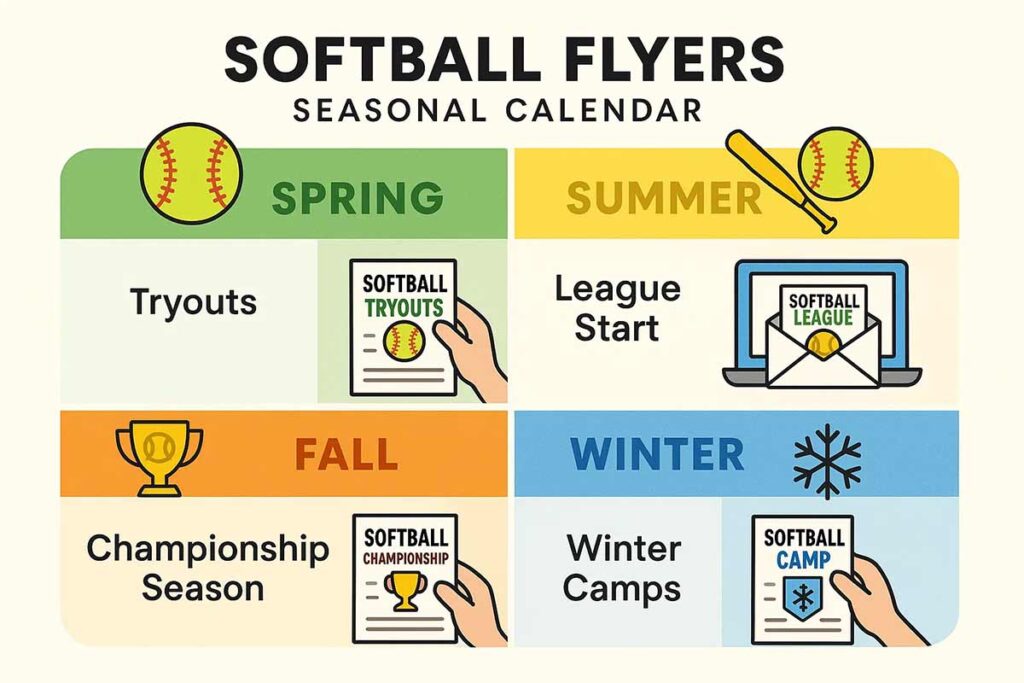
Seasonal Timing Strategies for Different League Types and Age Groups
Spring season distribution demands the earliest preparation, starting in late December when families plan summer activities. Begin softball flyer distribution 8-10 weeks before season starts, targeting January for March registration deadlines. Focus on New Year’s resolution timing when parents seek active programs for children.
Summer league promotion requires winter launch timing, starting February for May registration peaks. Parents book summer activities during school planning periods, making February-March crucial for visibility.
Fall season timing coincides with back-to-school energy, starting June distribution for August registration. Parents plan fall activities during summer break planning, requiring early summer visibility. Winter leagues need September launch for November registration, avoiding holiday conflicts.
Age-specific timing varies significantly. Younger age groups (6-10) register earlier as parents plan structured activities. Older age groups (11-14) register closer to season start as competitive considerations increase. Research indicates that youth sports participation patterns differ significantly across age groups, with younger children showing more structured enrollment patterns (Ohio State University, 2024).5
DesignWiz offers age‑specific softball flyer bright, playful designs for 6–10-year-olds and sleek, skill-focused layouts for pre-teens and teens each with live previews and simple customization.
- Join Our Softball Team Tryouts Flyer
- Dynamic Green 8U Softball Tryouts Registration Flyer
- Youth Softball Summer Camp Flyer
School Calendar Coordination for Maximum Reach and Parent Availability
School district calendar integration maximizes parent accessibility during decision-making periods. Coordinate with teacher conferences, school events, and parent meeting schedules for optimal visibility. Avoid testing periods when parents focus on academic priorities.
Parent-teacher conference timing provides concentrated parent audiences actively engaged in child development discussions. Schedule flyer distribution during conference weeks, targeting school locations and community centers with increased parent traffic.
Back-to-school periods create activity planning momentum, making August-September optimal for fall registration pushes. Parents actively seek extracurricular activities during school preparation, increasing softball flyer receptivity.
Registration fairs and school activity nights offer concentrated parent audiences. Coordinate with school administrators for table presence, combining direct distribution with face-to-face engagement opportunities.
Holiday and Break Period Considerations for Family Planning
Winter break timing captures family planning conversations and New Year’s activity resolutions. Distribute in early December before holiday chaos, targeting January decision-making periods. Avoid Christmas week through New Year’s Day when families focus on celebrations.
Spring break creates summer activity planning momentum. Parents book camps and leagues during vacation downtime, making March-April critical for summer program visibility. Target pre-break distribution to reach families during planning periods.
Summer vacation timing affects fall registration patterns. Parents plan fall activities during July-August downtime, requiring early summer distribution for autumn programs.
Major holiday avoidance prevents flyer waste and timing conflicts. Skip distribution during Thanksgiving week, Christmas/New Year periods, and major local holidays when families prioritize celebrations over activity planning.
Last-Minute Registration Push Techniques and Urgency Creation
Countdown marketing emphasizes approaching deadlines through visual urgency elements. Use “Registration closes in 5 days” messaging with deadline timers, creating immediate action motivation. Social media posts amplify urgency through countdown graphics and limited availability messaging.
Limited spot availability creates scarcity motivation, particularly effective for competitive programs. Highlight “Only 3 spots remaining” or “Waitlist forming” to encourage immediate registration decisions.
Social proof messaging leverages registration momentum: “50 players already registered” or “Teams filling quickly” creates community participation urgency. Include testimonials from previous season participants to build confidence and urgency.
Emergency registration tactics include extended hours, phone registration options, and simplified signup processes. Offer multiple registration methods during final weeks: online, phone, and in-person options to accommodate different parent preferences and schedules.
Strategic timing transforms softball flyer distribution from random placement to targeted engagement, maximizing registration success through coordinated seasonal planning and urgency creation.
Building Strategic Partnerships For Expanded Softball Flyer Reach
Building strategic partnerships for expanded softball flyer reach creates authentic community connections that multiply distribution effectiveness beyond individual efforts. Successful partnerships combine school relationships, municipal support, business collaborations, and sports organization alliances to establish credibility while accessing target demographics. Focus on mutual benefit opportunities where partners gain value through association with youth sports programming. Effective partnership strategies provide sustained visibility, cost-effective distribution channels, and community endorsement that increases sign-up conversion rates through trusted source validation.
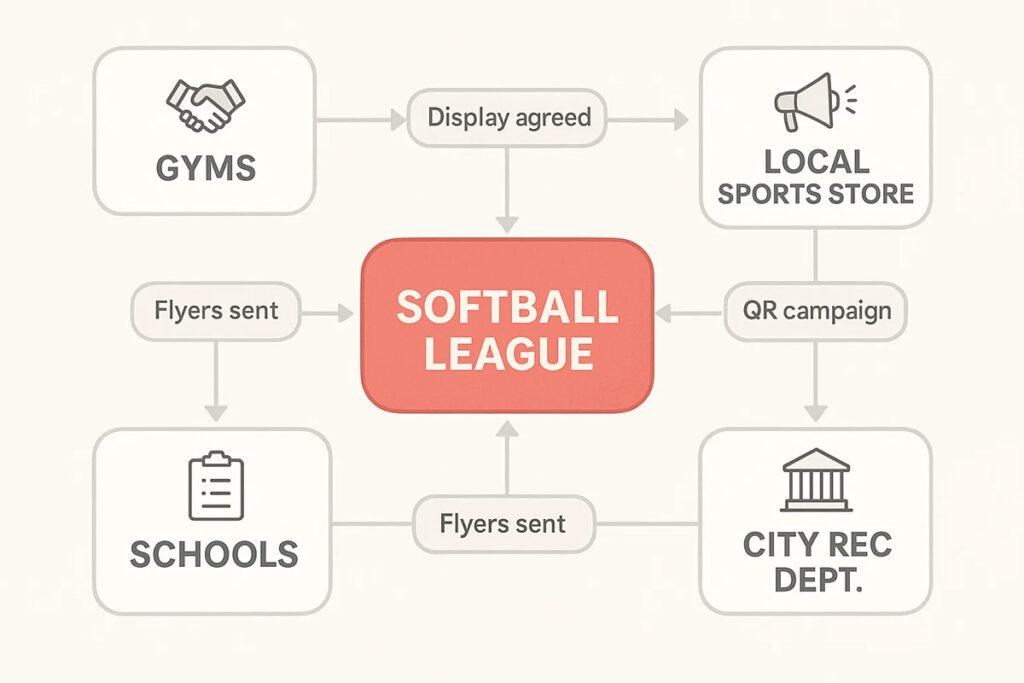
Collaborating with Local Schools and PTAs for Credibility and Reach
School partnerships provide direct access to target families through established communication channels and trusted relationships. Attend PTA meetings to present league programs, emphasizing educational benefits and community involvement opportunities. Volunteer for school events to build relationships with parents and staff members who influence family activity decisions.
Partner with physical education teachers and athletic coordinators who understand youth sports development and can recommend programs to interested families. Offer to provide softball equipment demonstrations or skills clinics at school events, positioning your league as a community resource rather than just another activity option.
Request permission to include softball flyer information in school newsletters, parent communication apps, and weekly folders sent home with students. Schools appreciate community partners who support youth development, making them more likely to assist with distribution efforts.
Sports Store and Equipment Retailer Partnerships for Target Audience Access
Equipment retailers naturally attract families interested in youth sports, making them ideal partnership locations for softball flyer distribution. Negotiate display space agreements where your flyers complement their spring sports equipment promotions and seasonal softball gear sales.
Develop cross-promotional opportunities where league registration includes equipment discounts or rental programs. This creates value for both partners while reducing financial barriers for participating families. Sporting goods stores benefit from increased foot traffic and equipment sales generated by league participation.
Coordinate timing with seasonal equipment sales to maximize exposure when families are already considering sports purchases. Retailers can include flyers with equipment purchases or display them prominently near checkout areas where parents make final purchasing decisions.
Cross-Promotion with Other Youth Sports Organizations for Shared Demographics
Partner with baseball, soccer, and basketball leagues that share similar demographics but operate in different seasons. Cross-promotional agreements allow each organization to reach families already committed to youth sports participation without competing for the same registration windows.
Develop joint registration events where multiple sports organizations share venue costs and combine marketing efforts. Families appreciate one-stop opportunities to explore various activity options for their children while organizations benefit from shared promotional expenses and increased visibility.
Coordinate with complementary sports that develop similar skills but don’t directly compete for participants. Many softball players also participate in volleyball or track, creating natural partnership opportunities with organizations serving these sports.
Municipal Recreation Department Alliances for Official Support
Municipal recreation departments provide official community endorsement that increases program credibility and expands distribution reach through government communication channels. Partner with city recreation staff to coordinate facility usage, field maintenance, and program scheduling.
The National Youth Sports Strategy emphasizes that effective youth sports programs require collaboration between “parents, coaches, organizations, communities, and policymakers to support youth sports participation for all” (U.S. Department of Health and Human Services, 2019).6
Seek official program designation through recreation department partnerships, which provides access to city websites, newsletters, and community event promotion. Municipal partnerships often include facility usage agreements that reduce operational costs while increasing program legitimacy.
Coordinate with seasonal recreation programming to complement rather than compete with municipal offerings. Many cities prefer partnering with established leagues rather than developing internal programs, creating mutually beneficial relationships that serve community needs.
These strategic partnerships create sustainable distribution networks that extend far beyond individual promotional efforts, building community connections that support long-term league growth and community integration while providing trusted endorsement that increases family participation rates.
Measuring And Tracking Your Softball Flyer Distribution Success
Measure softball flyer distribution success through registration tracking, location performance analysis, and conversion rate monitoring. Essential metrics include sign-up sources, cost per registration, location effectiveness, and timing optimization. Use registration codes, QR code tracking, and source attribution to identify successful distribution channels. Track metrics including flyer quantity distributed, registration conversion rates, location performance, and campaign ROI. Effective measurement requires consistent tracking systems, regular analysis, and optimization based on performance data.
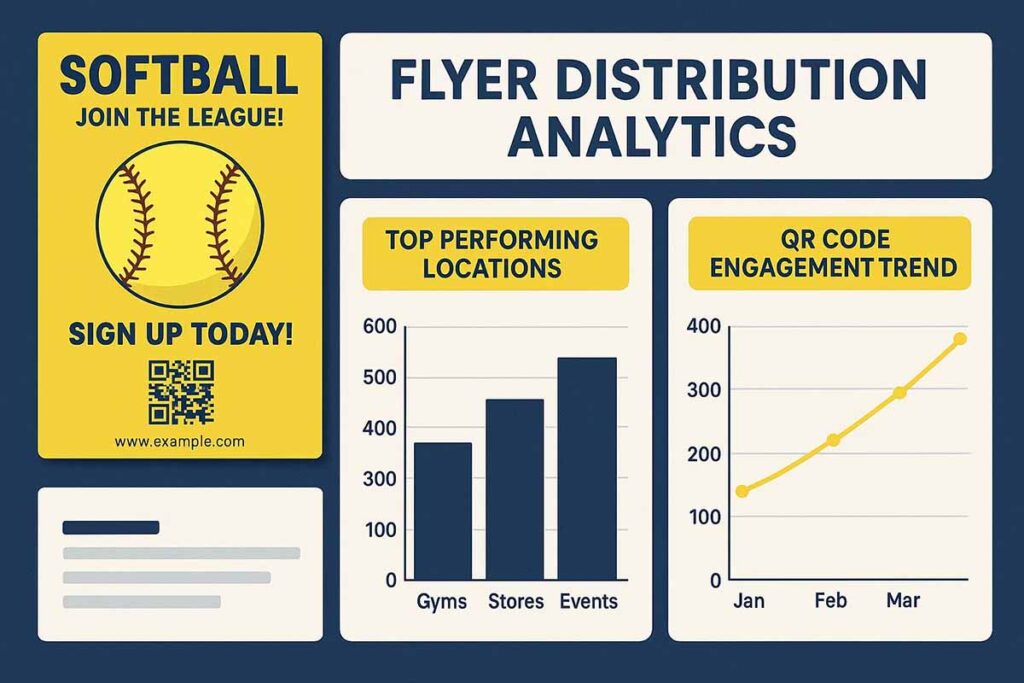
Essential Metrics for Softball Flyer Campaign Performance and ROI Analysis
Track core performance indicators to measure distribution effectiveness. Monitor registration conversion rates by location, calculating the percentage of flyers that generate actual sign-ups. Document cost per registration by dividing total distribution costs by new registrations. Measure location performance comparing high-traffic venues against community centers and schools. Track timing effectiveness, noting which distribution periods produce highest registration rates.
Calculate return on investment by comparing registration revenue against distribution costs. Most successful campaigns achieve 2-5% conversion rates from flyers to registrations. Track seasonal patterns to optimize future distribution timing. Monitor volunteer hours and material costs for complete ROI analysis.
Creating Trackable Registration Codes and Links for Source Attribution
Implement unique tracking codes for each distribution location. Create location-specific QR codes linking to registration pages with embedded tracking parameters. Use different phone numbers or website URLs for various distribution channels. Assign volunteers specific code ranges to track individual performance.
Digital tracking provides precise measurement capabilities. QR codes generate instant analytics showing scan rates, conversion times, and geographic data. Social media campaigns require platform-specific tracking through UTM parameters. Email distribution enables detailed open rates, click-through rates, and conversion tracking.
Follow-Up Strategies for Interested Prospects and Conversion Optimization
Develop systematic follow-up sequences for potential registrants. Create reminder campaigns for families who showed initial interest but haven’t completed registration. Use email automation to send deadline notifications and program benefits. Implement personal outreach for high-value prospects or community leaders.
Track follow-up effectiveness measuring response rates to different communication methods. Monitor conversion improvement from initial interest to final registration. Document which follow-up timing produces optimal results.
ROI Analysis for Different Distribution Channels and Strategy Optimization
Compare performance across all distribution channels. Schools typically generate 15-25% higher conversion rates than general community locations. Sports facilities produce qualified leads but may have lower overall volume. Digital distribution often shows higher initial engagement but requires stronger follow-up conversion.
Analyze cost-effectiveness factoring volunteer time, materials, and permission coordination. High-performing locations justify increased resource allocation. Underperforming channels require strategy adjustment or elimination. Track long-term value including family retention and referral generation.
People Also Ask About Softball Flyer Distribution
Where should I distribute softball tournament flyers for maximum attendance?
Distribute tournament flyers at youth sports complexes, team facilities, and league offices. Post in dugouts, bulletin boards, and coach areas with permission, ideally 4–6 weeks before the event for best visibility and registration.
How do I choose locations for softball tryout flyers?
Target middle and high schools, recreational leagues, and youth sports centers. Post in school athletic departments, recreation facilities, and training centers. Distribute 2-3 weeks before tryouts, aligning with school calendars for optimal parent and player engagement.
What are the best places to post softball fundraiser flyers?
Post fundraiser flyers at community centers, local businesses, grocery stores, and churches. Focus on family-heavy locations with community boards. Distribute 3-4 weeks before events, coordinating with community calendars to maximize donations and participation.
When is the best time to distribute softball camp flyers?
Distribute camp flyers in late winter or early spring, targeting summer camp registration. Post at recreation centers, schools, and pediatric offices. Align with school break schedules to reach parents planning summer activities for kids.
Where can I legally post softball clinic flyers?
Legally post clinic flyers on public bulletin boards, sports facilities, and school athletic departments with permission. Avoid private property without consent. Coordinate with recreation centers and youth programs, ensuring compliance with local posting regulations.
How do I track sign-ups from softball game flyer distribution?
Use unique registration codes or QR codes on game flyers to track sign-ups. Post at team facilities, community centers, and local businesses. Monitor conversion rates by location to optimize placement and timing strategies.
What’s the best strategy for distributing softball league flyers?
Distribute league flyers at schools, community centers, and municipal buildings. Target parent communication areas and public boards. Begin 6-8 weeks before the season, coordinating with school registration periods for maximum sign-ups.
FAQs About Softball Flyer Distribution
Start distribution 6–8 weeks before the season to give families time to plan, compare options, and register. Early outreach builds awareness and supports timely program planning.
Respect business decisions and stay professional. Offer mutual promotions, highlight community benefits, and target family-friendly, community-focused businesses for better results.
Replace flyers weekly or bi-weekly, depending on location, traffic, and weather conditions. Fresh flyers maintain visibility, update information, and demonstrate active promotion. Schedule regular distribution routes and coordinate with volunteers for consistent presence.
Physical distribution provides tangible presence and local visibility, while digital distribution offers broader reach and instant engagement. Combine both approaches for maximum effectiveness, using digital for tracking and physical for community presence.
Focus on differentiation through unique value propositions, superior design, and strategic placement. Avoid removing competitor materials, maintain professional standards, and emphasize your program’s unique benefits and community connections.
Use weather-resistant materials, covered locations, and protective displays. Plan indoor alternatives for harsh weather periods, coordinate timing with seasonal patterns, and maintain backup distribution strategies for weather-related delays.
Recruit from existing families, board members, and community supporters. Create simple distribution kits, provide clear instructions, and recognize volunteer contributions. Schedule group distribution events and coordinate with team parent volunteers.
Comply with local solicitation laws, respect private property rights, and follow business posting policies. Obtain necessary permissions, maintain insurance coverage, and ensure content accuracy for liability protection and community credibility.
Conclusion
Building a successful softball flyer distribution system takes more than just posting flyers, it requires a strategic approach. Focus on high-traffic family locations, align with seasonal registration windows, and maintain consistent visibility through community partnerships and volunteer support.
Combine physical placements with digital efforts like QR codes, email campaigns, and parent-focused social media groups. Develop relationships with schools, local businesses, and recreation departments to ensure long-term distribution access. And don’t forget to start with editable flyer templates that you can tailor to each channel for consistent branding.
Track performance through sign-up data and location metrics to refine your strategy each season. With the right planning, partnerships, and ongoing optimization, your distribution efforts will drive sign-ups and create lasting community impact.
Reference
- Building Equity and Accessibility into Youth Sports. Published September 27, 2024. George Mason University – College of Education and Human Development.
- The NRPA Park and Recreation Marketing and Communications Report. National Recreation and Park Association. (2020).
- Organized Sports Participation Among Children Aged 6–17 Years: United States, 2020. NCHS Data Brief, no 441. Centers for Disease Control and Prevention. (2022).
- Maximizing Youth Sports Engagement on Social Media: How Visual Impact and Message Appeal Shape Consumer Responses Online. The Sport Journal. Jung, W. S., Jang, W. Y., & Rhee, S. R. (2024).
- Organized youth sports are increasingly for the privileged. Ohio State University. (2024).
- The National Youth Sports Strategy. U.S. Department of Health and Human Services, Office of Disease Prevention and Health Promotion. (2019).
